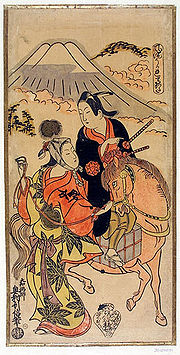
Urushi-e
Encyclopedia

Lacquer
In a general sense, lacquer is a somewhat imprecise term for a clear or coloured varnish that dries by solvent evaporation and often a curing process as well that produces a hard, durable finish, in any sheen level from ultra matte to high gloss and that can be further polished as required...
picture," refers to two types of Japanese art
Japanese art
Japanese art covers a wide range of art styles and media, including ancient pottery, sculpture in wood and bronze, ink painting on silk and paper and more recently manga, cartoon, along with a myriad of other types of works of art...
works: paintings painted with actual lacquer, and particular woodblock printing
Woodblock printing in Japan
Woodblock printing in Japan is a technique best known for its use in the ukiyo-e artistic genre; however, it was also used very widely for printing books in the same period. Woodblock printing had been used in China for centuries to print books, long before the advent of movable type, but was only...
styles which use regular ink but are said to resemble the darkness and thickness of black lacquer.

Prints
Urushi-e woodblock prints were made using thick, dark black lines, and were sometimes hand-colored. The ink was mixed with an animal-based glue called nikawa, which thickened it and gave it a lustrous shine, said to resemble lacquer. Most often, this was used not in creating the entire print, but only in enhancing a particular element, such as an obiObi
Obi may refer to:* Obi , a sash worn with a kimono or with the uniforms used by practitioners of Japanese martial arts* Obi-Wan Kenobi, fictional character from the Star Wars universe...
or a figure's hair, to give it shine and make the image more luxurious overall.
Prints which include urushi-e elements are likely to also feature the use of mica
Mica
The mica group of sheet silicate minerals includes several closely related materials having highly perfect basal cleavage. All are monoclinic, with a tendency towards pseudohexagonal crystals, and are similar in chemical composition...
, metal dusts, and other elements which enhanced the appearance, quality and value of the works. The technique was most popular in the early 18th century, and can be seen in works by Okumura Masanobu
Okumura Masanobu
was a Japanese print designer, book publisher, and painter. He also illustrated novelettes and in his early years wrote some fiction. At first his work adhered to the Torii school, but later drifted beyond that. He is a figure in the formative era of ukiyo-e doing early works on actors and bijinga...
, Torii Kiyomasu
Torii Kiyomasu
was a Japanese painter and printmaker of the Torii school, in the genre of ukiyo-e. Like the other Torii artists, his primary focus was on Kabuki billboards, advertisements, actor prints, and other related material...
and Torii Kiyonobu, among many others.
Paintings
In painting, the term refers to the use of colored lacquers, produced by mixing pigments with clear lacquer. The use of colored lacquer for painting goes back to the prehistoric Jōmon periodJomon period
The is the time in Japanese prehistory from about 14,000 BC to 300 BC.The term jōmon means "cord-patterned" in Japanese. This refers to the pottery style characteristic of the Jōmon culture, and which has markings made using sticks with cords wrapped around them...
, and became especially popular in the Nara period
Nara period
The of the history of Japan covers the years from AD 710 to 794. Empress Gemmei established the capital of Heijō-kyō . Except for 5 years , when the capital was briefly moved again, it remained the capital of Japanese civilization until Emperor Kammu established a new capital, Nagaoka-kyō, in 784...
(8th c.), when a great many works were made using red lacquer against a black background. Until the 19th century, however, the use of natural pigments restricted the colors accessible to artists to red, black, yellow, green, and light brown.
Artist Shibata Zeshin
Shibata Zeshin
was a famous and revolutionary Japanese painter and lacquerer of the late Edo period and early Meiji era. In Japan, he is ironically known as both too modern, a panderer to the Westernization movement, and also an overly conservative traditionalist who did nothing to stand out from his contemporaries...
(1807-1891) is particularly famous for his innovations in this regard, and was perhaps the first to use lacquer not just as a decorative element (in painting boxes, furniture, and pottery) but as a medium for painted scrolls. Zeshin experimented extensively with various substances, which he mixed with lacquer to create a variety of effects, including simulating the appearance of various metals (iron, gold, bronze, copper), and imitating the appearance and texture of Western oil painting
Oil painting
Oil painting is the process of painting with pigments that are bound with a medium of drying oil—especially in early modern Europe, linseed oil. Often an oil such as linseed was boiled with a resin such as pine resin or even frankincense; these were called 'varnishes' and were prized for their body...
.

